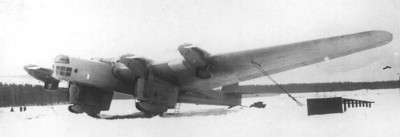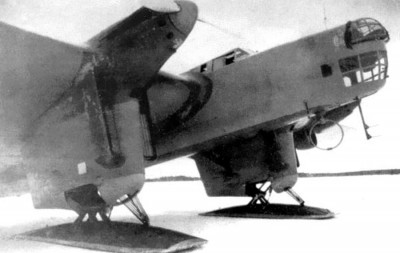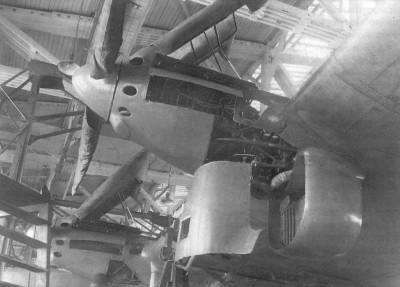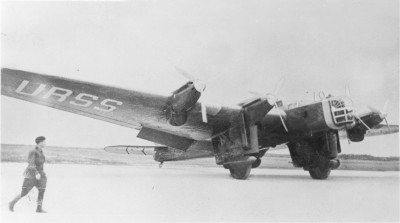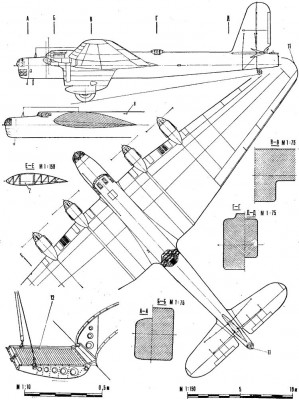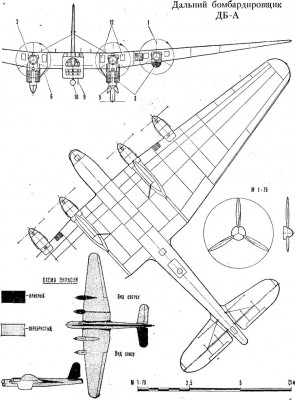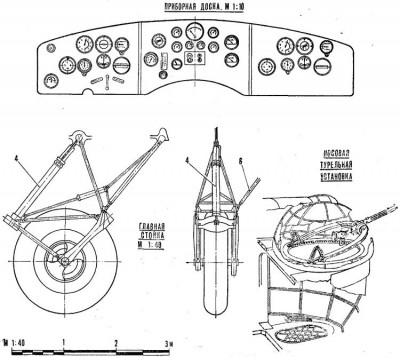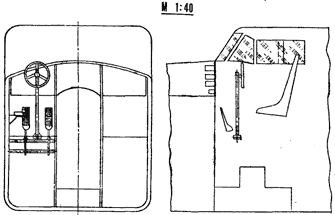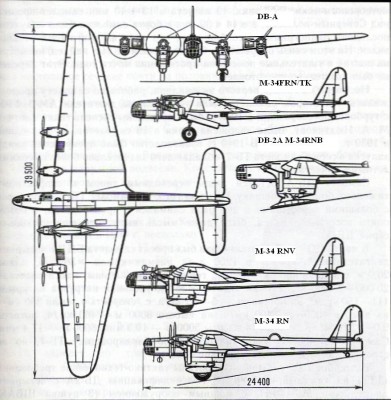| Název: Name: | Bolchovitinov DB-A 4M-34RN | Bolkhovitinov DB-A 4M-34RN |
| Originální název: Original Name: | Болховитинов ДБ-А 4М-34РН | |
| Kategorie: Category: | bombardovací letoun | bomber aeroplane |
| Výrobce: Producer: | DD.MM.1934-DD.MM.1934 Moskevský letecký závod č. 22 S. P. Gorbunova, Moskva | |
| Období výroby: Production Period: | DD.MM.1934-DD.MM.1934 | |
| Vyrobeno kusů: Number of Produced: | 1 | |
| První vzlet: Maiden Flight: | 02.05.1935 | |
| Osádka: Crew: | 9 | |
| Základní charakteristika: Basic Characteristics: | ||
| Vzlet a přistání: Take-off and Landing: | CTOL - konvenční vzlet a přistání | CTOL - conventional take-off and landing |
| Uspořádání křídla: Arrangement of Wing: | jednoplošník | monoplane |
| Uspořádání letounu: Aircraft Concept: | klasické | conventional |
| Podvozek: Undercarriage: | zatahovací | retractable |
| Přistávací zařízení: Landing Gear: | kola/lyže | wheels/ski |
| Technické údaje: Technical Data: | ||
| Hmotnost prázdného letounu: Empty Weight: | 15400 kg | 33951 lb |
| Vzletová hmotnost: Take-off Weight: | 21960 kg | 48414 lb |
| Maximální vzletová hmotnost: Maximum Take-off Weight: | 27670 kg | 61002 lb |
| Rozpětí: Wingspan: | 42,10 m | 138ft 1,48in |
| Délka: Length: | 25,12 m | 82ft 4,98in |
| Výška: Height: | 9,21 m | 30ft 2,6in |
| Plocha křídla: Wing Area: | 237,00 m2 | 2551.05 ft2 |
| Plošné zatížení: Wing Loading: | 92,66 kg/m2 | 18.98 lb/ft2 |
| Pohon: Propulsion: | ||
| Kategorie: Category: | pístový | piston |
| Počet motorů: Number of Engines: | 4 | |
| Typ: Type: | Mikulin AM-34RN o výkonu 618 kW/840 k dvoulistá dřevěná vrtule, později třílistá stavitelná | Mikulin AM-34RN, power 828 hp two-bladed wooden, later three-bladed variable-pitch propeller |
| Objem palivových nádrží: Fuel Tank Capacity: | 9100 kg | 20062 lb |
| Výkony: Performance: | ||
| Maximální rychlost: Maximum Speed: | 330 km/h v 4200 m | 205.1 mph in 13780 ft |
| Cestovní rychlost: Cruise Speed: | ? km/h v ? m | ? mph in ? ft |
| Rychlost stoupání: Climb Rate: | ? m/s | ? ft/min |
| Čas výstupu na výšku: Time to Climb to: | 13 min do 5000 m | 13 min to 16404 ft |
| Operační dostup: Service Ceiling: | 7220 m | 23688 ft |
| Dolet: Range: | ? km | ? mi |
| Maximální dolet: Maximum Range: | 5000 km | 3106.9 mi |
| Výzbroj: Armament: | 1x kulomet ŠKAS ráže 7,62 mm v příďové věži Tur-8 1x kanon ŠVAK ráže 20 mm ve hřbetní věži Tur-Aldis 1x pohyblivý kulomet ŠKAS ráže 7,62 mm pod trupem 1x pohyblivý kulomet ŠKAS ráže 7,62 mm na zádi 3000 kg pum | 1x 7.62 mm ShKAS machine gun in the Tur-8 nose turret 1x 20 mm ShVAK cannon in the Tur-Aldis dorsal turret 1x flexible 7.62 mm ShKAS machine gun in the floor hatch 1x flexible 7.62 mm ShKAS machine gun in the tail 6614 lb of bombs |
| Uživatelské státy: User States: | - | - |
| Poznámka: Note: | - později přestavěn pro dálkový let přes severní pól - odstraněna výzbroj, nová příď, motory M-34RNV | - |
| Zdroje: Sources: | Якубович, Н. Дальний бомбардировщик - Академия, Крылья Родины 1997/11-12. Maslov, Mikhail. Le DB-A ou la Croix Tombale. Air Magazine No.06, 2002/01. Бюшгенс Г. С. самолетостроение в СССР 1917-1945. ЦАГИ 1992. topwar.ru http://ram-home.com/ram-old/db-a.html | |
Bolchovitinov DB-A 4M-34RN
Bolkhovitinov DB-A 4M-34RN
Болховитинов ДБ-А 4М-34РН
Bolchovitinov DB-A
( Болховитинов ДБ-А)
At the turn of the twenties and thirties of the last century, the Soviet Union paid considerable attention to the development and production of heavy transport, respectively. bomber aircraft, as evidenced by the well-known four-engine bomber Tupolev TB-3, which took off in the early thirties. An advanced aluminum corrugated sheet was used as a coating at that time, but its significant drawback was its considerable resistance, which reduced both flight speed and range.
After the discovery of solid and rigid duralumin, there was an immediate opportunity to produce new generation heavy aircraft with a smooth coating. One of the first of its kind was a long-range bomber designed by the approximately 20-member design group of the Military Aviation Academy N.E.Zhukovsky ( Военно-воздушнaйa академиa имени Н.Е. Жуковского) headed by V.F. Bolchovitinov. He was originally a member of the A.N.Tupolev group, who, however, withdrew from cooperation because at that time he was already working on his own project TB-7.
The technical requirements for the new aircraft were considerable - the maximum speed of at least 310 km/h (TB-3 reached at that time max. 278 km/h), access 6000-7000 m (TB-3 - 3800 m) and load capacity up to 5000 kg (TB-3 max. 4000 kg). Work on the project and construction of a long-range bomber, which was given the designation DB-A, which was short for Long-range bomber of the Academy (ДБ-А дальний бомбардировщик Академии), the first prototype. Although the original intention was to modernize Tupolev's TB-3, the result was basically a new aircraft, conceptually only slightly reminiscent of its model.
DB-A was an all-metal mid-plane of semi-shell construction with solid landing gear legs with wheels retractable into the landing gear. The rear spur wheel was fully retractable into the fuselage. Beneath the centerplane was a bomb bay 6 meters long and 2 meters wide, in which a total of 5,000 kg of bombs could be carried. Under the wing were placed bomb hangers for a total of 2,000 kg of bombs. The armament was originally made up of four machine guns ŠKAS cal. 7, 62 mm and one large-caliber machine gun UBT cal. 12, 7 mm, later it was strengthened to six machine guns ŠKAS and one cannon ŠVAK (in the nasal part). A total of 3,000 rounds were carried for machine guns, the firing range of the cannon was 250 grenades.
The crew consisted of 9 people. The machine was powered by four engines AM-34FRN, resp. AM-34RNB which spun three-bladed metal propellers, the first prototype had AM-34RN engines. The empty weight of the first prototype was 15,400 kg, the volume of fuel tanks was 14,000 liters.
The first takeoff of the prototype took place on May 2, 1935, and initial tests showed that the project fully met the requirements that were placed on it. The factory tests performed by pilots N.G. Kastanaev and J.N. Mojsejev were completed on March 5, 1936 and smoothly passed the state tests, which ended in June of the same year. With a take-off weight of 19,500 kg, the machine was capable of horizontal flight with two working engines at an altitude of 2,500 m, with three engines, its maximum access was 5,100 meters. Other achieved values also pointed to its predominance over TB-3. The speed was higher by 42-50 km/h, a runway of 400 meters was enough for takeoff, for landing he needed 300 meters at a landing speed of 85 km/h. After eliminating several shortcomings, the tests were repeated with AM-34RNV engines, and after state tests, the type was recognized as fully suitable for inclusion in production.
On this machine on November 10, 1936, pilots M.A. Njuchtikov and M.A. Lipkin broke two international records, when they carried into the air a load of 10,000 kg (up to 7,032 m) and ten days later, on November 20, 1936, even 13,000 kg to a height of 4,535 meters. This year, preparations also began for a long-distance flight from Moscow via the North Pole to Alaska to the city of Fairbanks in the USA. The machine underwent 200 hours of stationary engine testing and was assigned the designation of the Air Force N-209 (Н-209). In preparation, he successfully completed a training flight on the route Ščelkovo-Baku-Ščelkovo (ковелково-Баку-čелково). Special attention was paid to the preparation of the takeoff, as for the planned distance of 8,440 km was needed 16.4 tons of fuel, which doubled the standard and increased the total weight of the machine to 34, 7 tons. Attention was also paid to anti-icing measures, so important for flights in the Arctic, and therefore an aircraft was mounted on the aircraft to spray the blades of alcohol.
All preparatory work was completed in August/August 1937 and at the same time the crew was selected - Commander SALevanevsky, co-pilot NGKastanaev (former military test pilot), sturman Vilevchenko (well-known polar explorer), radio operator NJGalkovsky, flight mechanic NNGodovikov, second on-board mechanic GTPobozimov. The takeoff, which took place on August 12, 1937, and the flight itself took place for the first twenty hours without any problems, but after flying over half of the Barents Sea, the plane flew into a continuous cloud. After flying over the North Pole, the plane took a course along 148 parallel in the direction of the city of Fairbanks. Shortly afterwards, a laconic radiogram was received stating that the right outboard engine had failed due to a fault in the oil line, and then two messages arrived, indicating that the flight was continuing. Then the connection was cut off and they waited in vain for Bolchovitinov's machine at Fairbanks. Despite an extensive search lasting almost one year, in which 24 Soviet and 7 foreign aircraft took part, no traces of the missing expedition were found.
However, work on long-range bombers continued despite this catastrophe, and in 1938 state tests of the second prototype with engines took place M-34FRNwith turbochargers and adjustable pitch propellers (pilot NANjuchtikov). The test results were good, so the production of sixteen serial machines was started, of which only twelve pieces were completed in 1939, because the production capacity was needed for the production of a new type TB-7, constructed in OKB ANTupoleva brigade VMPetľjakova.
For the sake of completeness, it should be mentioned that in December 1939 the tactical and technical requirements for the heavy cruiser TK-1 ( heavy cruiser) with engines M-34FRN and strong armament consisting of three cannons ŠVAK, five machine guns ŠKAS and eight rockets RS. Not only the armament but also the carried stockpile of ammunition was unusual - 11,000 rounds for machine guns and 3,000 grenades for cannons. However, an aircraft with such TTDs remained only at the design stage.
resources:
Modelist + Constructor
Šavrov, V.B .: Istorija konstrucij samolotov v SSSR 1938-50, Mašinostrojenije, 1988
Reklama
http://www.airwar.ru/enc/bww1/dba.html
http://aviadejavu.ru/Site/Crafts/Craft26644.htm
. | Period | - |
| Producer | - |
| Type | Bolchovitinov DB-A 4M-34RN |
| Camouflage | - |
| Country | - |
| Pilot | - |
| Production No. | - |
| Serial No. / Evidence No. | - |
| Tactical Marking / Imatriculation | - |
| Name | - |
| Unit | - |
| Base | - |
| Date (DD.MM.RRRR) | DD.MM.RRRR |
| Author | - |
| Print size / 300 DPI | - |
| Published with authors permit | - |
| Author Website | - |
DB-A ještě s dvoulistými vrtulemi.
| Period | - |
| Producer | - |
| Type | Bolchovitinov DB-A 4M-34RN |
| Camouflage | - |
| Country | - |
| Pilot | - |
| Production No. | - |
| Serial No. / Evidence No. | - |
| Tactical Marking / Imatriculation | - |
| Name | - |
| Unit | - |
| Base | - |
| Date (DD.MM.RRRR) | DD.MM.RRRR |
| Author | - |
| Print size / 300 DPI | - |
| Published with authors permit | - |
| Author Website | - |
| Period | - |
| Producer | - |
| Type | Bolchovitinov DB-A 4M-34RN |
| Camouflage | - |
| Country | - |
| Pilot | - |
| Production No. | - |
| Serial No. / Evidence No. | - |
| Tactical Marking / Imatriculation | - |
| Name | - |
| Unit | - |
| Base | - |
| Date (DD.MM.RRRR) | DD.MM.RRRR |
| Author | - |
| Print size / 300 DPI | - |
| Published with authors permit | - |
| Author Website | - |
Na lyžích z TB-3.
| Period | - |
| Producer | - |
| Type | - |
| Camouflage | - |
| Country | - |
| Pilot | - |
| Production No. | - |
| Serial No. / Evidence No. | - |
| Tactical Marking / Imatriculation | - |
| Name | - |
| Unit | - |
| Base | - |
| Date (DD.MM.RRRR) | DD.MM.RRRR |
| Author | - |
| Print size / 300 DPI | - |
| Published with authors permit | - |
| Author Website | - |
www.shu-aero.com
.| Period | - |
| Producer | - |
| Type | Bolchovitinov DB-A 4M-34RN |
| Camouflage | - |
| Country | - |
| Pilot | - |
| Production No. | - |
| Serial No. / Evidence No. | - |
| Tactical Marking / Imatriculation | - |
| Name | - |
| Unit | - |
| Base | - |
| Date (DD.MM.RRRR) | DD.MM.RRRR |
| Author | - |
| Print size / 300 DPI | - |
| Published with authors permit | - |
| Author Website | - |
Po přestavbě pro dálkový let, 1937.
This post has not been translated to English yet. Please use the TRANSLATE button above to see machine translation of this post.
Popisky k výkresom z Modelist konstruktor:
1 - vrtuľové lopatky, 2 - letecký motor M-34 RNB, 3 - chladič, 4 - olejový pneumatický podvozkový tlmič, 5 - podvozok, 6 - vzpera podvozku, 7 - benzínová nádrž, 8 - Venturiho trubica, 9 - приемник воздушного давления (?), 10 - anténa rádiokompasu APR-3, 11 - navigačné svetlá (ľavé - červené, pravé - zelené, chvostové - biele), 12 - odklápacia lavica pre údržbu motorov
| Period | - |
| Producer | - |
| Type | - |
| Camouflage | - |
| Country | - |
| Pilot | - |
| Production No. | - |
| Serial No. / Evidence No. | - |
| Tactical Marking / Imatriculation | - |
| Name | - |
| Unit | - |
| Base | - |
| Date (DD.MM.RRRR) | - |
| Author | - |
| Print size / 300 DPI | - |
| Published with authors permit | - |
| Author Website | - |
časopis Modelist Konstruktor č. 8/1983
| Period | - |
| Producer | - |
| Type | - |
| Camouflage | - |
| Country | - |
| Pilot | - |
| Production No. | - |
| Serial No. / Evidence No. | - |
| Tactical Marking / Imatriculation | - |
| Name | - |
| Unit | - |
| Base | - |
| Date (DD.MM.RRRR) | - |
| Author | - |
| Print size / 300 DPI | - |
| Published with authors permit | - |
| Author Website | - |
časopis Modelist Konstruktor č. 8/1983
| Period | - |
| Producer | - |
| Type | - |
| Camouflage | - |
| Country | - |
| Pilot | - |
| Production No. | - |
| Serial No. / Evidence No. | - |
| Tactical Marking / Imatriculation | - |
| Name | - |
| Unit | - |
| Base | - |
| Date (DD.MM.RRRR) | - |
| Author | - |
| Print size / 300 DPI | - |
| Published with authors permit | - |
| Author Website | - |
časopis Modelist Konstruktor č. 8/1983
| Period | - |
| Producer | - |
| Type | - |
| Camouflage | - |
| Country | - |
| Pilot | - |
| Production No. | - |
| Serial No. / Evidence No. | - |
| Tactical Marking / Imatriculation | - |
| Name | - |
| Unit | - |
| Base | - |
| Date (DD.MM.RRRR) | - |
| Author | - |
| Print size / 300 DPI | - |
| Published with authors permit | - |
| Author Website | - |
časopis Modelist Konstruktor č. 8/1983
| Period | - |
| Producer | - |
| Type | - |
| Camouflage | - |
| Country | - |
| Pilot | - |
| Production No. | - |
| Serial No. / Evidence No. | - |
| Tactical Marking / Imatriculation | - |
| Name | - |
| Unit | - |
| Base | - |
| Date (DD.MM.RRRR) | - |
| Author | - |
| Print size / 300 DPI | - |
| Published with authors permit | - |
| Author Website | - |
Šavrov, V.B.: Istorija konstrucij samolotov v SSSR 1938-50
Reklama
Join us
We believe that there are people with different interests and experiences who could contribute their knowledge and ideas. If you love military history and have experience in historical research, writing articles, editing text, moderating, creating images, graphics or videos, or simply have a desire to contribute to our unique system, you can join us and help us create content that will be interesting and beneficial to other readers.
Find out more